Troy: excavation
Q22647Ilion or Troy: town in northwestern Asia Minor, famous for the legendary Trojan War, in which a coalition of Mycenaean warriors captured the city of king Priam. Homer's Iliad deals with an episode from this war.
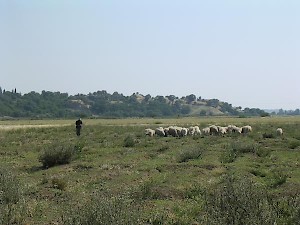
Αἰπύ, as Homer calls the ancient city of Troy near the Hellespont, is almost certainly identical to the Wilusa that is called "steep" in the Hittite sources. The ancient town raises so steeply from the plain because it is built on a rocky outcrop, while the plain is a younger alluvium.
The main reason, however, is that Troy consists of nine levels of occupation on top of each other. Every time a town was destroyed, a new one was built on top of it. This makes the site extremely high, and complex. It is a classical tell.
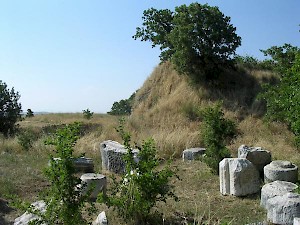
It was one of the first tells that archaeologists were to investigate and Troy's famous main excavator, the German business man Heinrich Schliemann (1822-1890), decided to leave several small "pinnacles" unexcavated, so that future generations would be able to check his interpretations. After all, archaeology still was a science in its infancy and Schliemann realized that, as all humans would inevitably do, he would make mistakes.
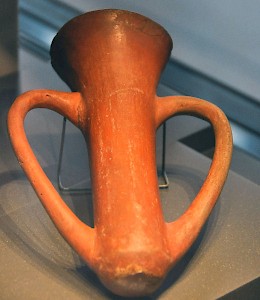
And to be honest, he made many mistakes, even according to standards that were beginning to emerge in his own age. Accepting the classical tradition, he believed that he had to look for a city with strong walls that had been destroyed by fire. This was a working hypothesis that could be checked, but he was unprepared for more than one level of occupation. As a consequence, he ruthlessly removed everything that showed no traces of fire, until he found what he was looking for: the layer now known as Troy II, which he believed to be Homeric Troy.
When he interpreted his finds, he often looked in the Iliad and Odyssey first, even when there was no real need to. For example, he considered the find of a two-handed cup as proof of the veracity of Homer's poems, because the poet once referred to a δέπας ἀμφκύπελλον, "two-handed cup".note
Later, he concluded that he had been wrong, and decided to check whether Troy VI, where he had found the grey ceramics that he had also found in Mycene and Orchomenus, could be the city he had been looking for. He died before he could execute his plan.
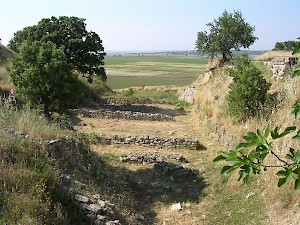
It was left to his former assistant Wilhelm Dörpfeld (1853-1940) to check the site again, and he established that Troy VI had indeed been the city that existed in the Late Bronze Age, contemporaneously with Mycene. Unfortunately, it was later established that this city had been destroyed by an earthquake. Troy VIIa was looted and sacked, but this happened in an age in which Late Helladic IIIC ceramics were common, a type of pottery not found in the great Mycenaean palaces. In other words: Troy VI was a splendid city and existed at the right moment, but was destroyed by an earthquake; Troy VIIa was destroyed after a war, but in an age in which the Mycenaeans were no longer capable of organizing an expedition.
This simply means that Homer did not describe a historical event, and that is not surprising. Epics are not about historical facts, but about heroes. In the Nibelungenlied, stories about the downfall of the Burgundian dynasty have been combined with stories about a Frankish dragon slayer and a court intrigue among the Gepids; the author of the Chanson de Roland has managed to introduce the wrong enemy. Greek epics are no exception.
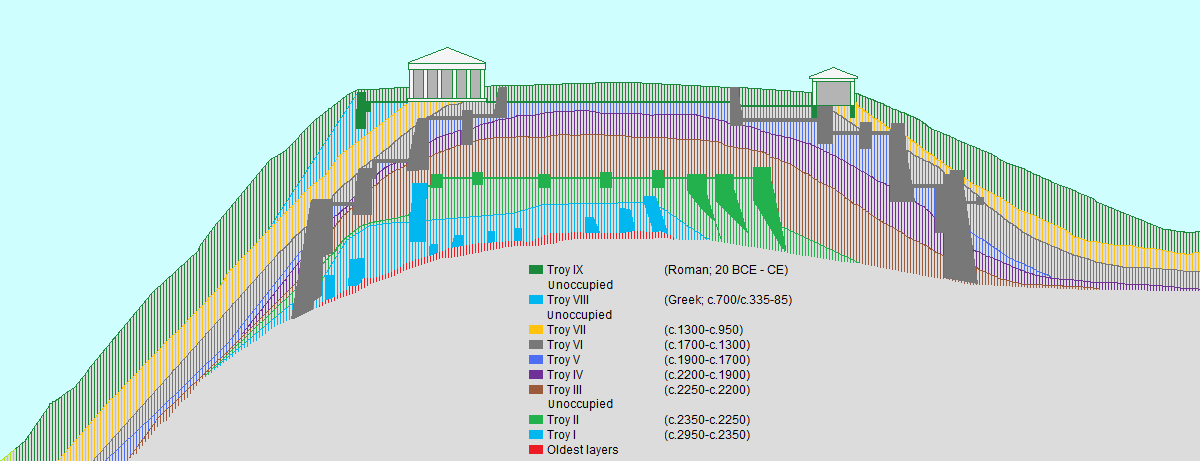
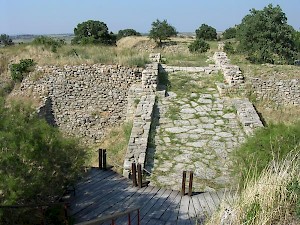
There is some confusion about the nomenclature of the earliest phases of Trojan history. The dozens of strata that have been identified, can be divided neatly into these nine main groups. How complex things really are, becomes clear when we look at Troy I and II. The American archaeologist Carl Blegen (1887-1971) established that there were 25 levels preceding Troy I and that Troy I and II together contained 18 levels. However, Manfred Korfmann, who investigated the site in the late twentieth century, counted 22 levels within Troy I and II and established that several strata that used to be categorized as Troy II are in fact closer to Troy I.
Because the chronology of the site has become so fragmented, a new way of organizing Troy's history has been introduced: instead of looking at the city itself, archaeologists look at the cultural context in which it existed.
- The three first cities were part of an Early Bronze Age civilization of the northeastern Aegean Sea. They share the development of the isle of Lemnos, and the ceramics are identical to Lesbos, Smyrna, and Samos.
- Troy IV and V, on the other hand, were - from a cultural point of view - more oriented on the Anatolian Middle Bronze civilizations.
- The beginning of Troy VI marks a major break: we enter the Late Bronze Age, which continues into VIIa. Troy is trading partner of almost everyone - even the pharaoh appears to have had dealings with "Wily".
- Troy VIIb, the first Iron Age culture, is open to influences from the Balkans.
- After this, the city was unoccupied for some time; Troy VIII is a normal Hellenistic city, and Troy IX was a typical town of the Roman Empire.
| Troy IX | Roman Troy | 20 BCE - c.500 CE |
| (Unoccupied) | ||
| Troy VIII | Hellenistic Troy | c.330-85 BCE |
| Sanctuary | c.700-c.330 | |
| (Unoccupied) | ||
| Troy VIIb3 | c.1025-c.950 | |
| Troy VIIb2 | Balkan Troy | c.1125-c.1025 |
| Troy VIIb1 | c.1200-c.1100 | |
| Troy VIIa | c.1300-c.1200 | |
| Troy VIh | Late Bronze Troy | c.1400-c.1300 |
| Troy VI a-g | c.1700-c.1300 | |
| Troy V | Anatolian Troy | c.1900-c.1700 |
| Troy IV | (Middle Bronze Troy) | c.2200-c.1900 |
| Troy III | c.2250-c.2200 | |
| Troy II | Maritime Troy | c.2350-c.2250 |
| Troy I | c.2950-c.2350 |